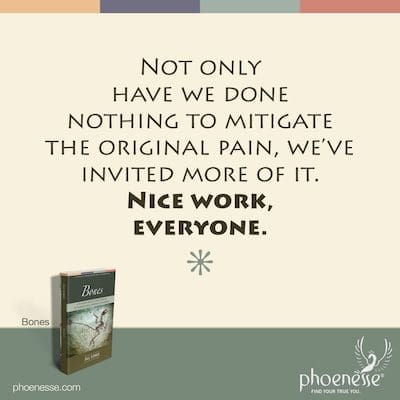At some point along our spiritual path, we will run into certain problems and patterns in our soul and it will happen: we will encounter our pain. So let’s talk about pain, and more importantly how to dissolve pain. Because we might have noticed by now, it’s not going to just go away on its own.

Let’s recap how we got here. It all starts in childhood, where the child suffers due to shortcomings in Mom and Dad’s ability to love. We not only felt like we didn’t get enough affection, we didn’t feel fully accepted as individual. The cause is the common practice of parents treating children as, well, children, and not as whole people. We might never have thought about this quite in this way before. But being treated as a child can leave as much of a scar as being neglected or treated cruelly. It’s incredibly frustrating.
The climate we grew up in affected us. It was like perpetually receiving a minor shock. And this often leaves a bigger mark than enduring a single traumatic experience. As such, the latter is easier to cure than the former. For continually feeling as though we are unacceptable, coupled with a lack of love and understanding, creates what we typically call a neurosis.
We didn’t know any better so we accepted the climate as being how it had to be. And we came to take it for granted. We suffered and believed our suffering was unchangeable, which conditioned us to create defenses—highly destructive defenses.
Then we repressed the original frustration and pain we couldn’t deal with, and put it out of our awareness. There it still smolders in the unconscious mind. Then destructive images began to take shape and our defense mechanisms of aggression, submission and/or withdrawal fully developed. These are really pseudo-solutions, meaning they are false solutions that don’t work worth a hoot. We use them daily to battle the world and the pain it inflicts. Our images are also a form of defense. They are designed to fight against painful experiences by erecting a rigid wall constructed entirely from wrong conclusions.
For those of us who opt for the pseudo-solution of withdrawing—from feelings, from people, from certain situations…in short, from life—we’re defending ourselves against being hurt. Too bad this is such a shortsighted and ineffective remedy. Once we get wind of this, we’ll want to change our ways. We’ll come to realize that pain feels a whole lot better than being alienated from ourselves and feeling numb.
Further on down the road of healing, we’ll go through times of resistance and becoming discouraged. Eventually we will reach the point when the hard shell inside us breaks open and we are no longer dead inside. Glory be and hallelujah. That, however, won’t exactly be our first reaction. It can’t be. Because the first thing we will become aware of will be all the dark, repressed emotions and the associated pain that we’ve been squirrelling away.
We were right, we’ll think, to have tried to withdraw. But now the only path open is to plow straight ahead until we reach the reward of uncovering good and constructive feelings. Praise be, with genuine, positive feeling this time.
Those who prefer the pseudo-solution of submissiveness elect the route of weakness and helplessness. We’ll also opt for the thrilling dependency of having someone else care for us. Perhaps not materially, but emotionally for sure. We must come to see the unsatisfactory nature of this option as well. Being dependent makes us fearful and helpless, and takes the wind out of our I-believe-in-me sails. So then we withdraw, deciding for dead inside instead, which makes life seem completely meaningless. Feeling robbed of our strength and the wherewithal to stand on our own feet, we arrive at isolation. We just followed a different itinerary to get here.
So we set out with a plan to avoid feeling pain by finding someone strong to watch over us. But since it’s not possible to find such a person, we ended up causing ourselves far more grief. That person, it turns out, can only be ourselves.
Dollars to donuts, if our strategy is to make ourselves deliberately weak, we are actually wanting to lord ourselves over others. There is, in fact, no worse tyranny than what a weak person exerts over everything and everyone in their path. It’s akin to saying: “I am so weak, you simply must help me. I am making you responsible for me. The mistakes I make don’t count because I don’t know any better. I can’t help it. You have to indulge me and let me get away with anything. You can’t expect me to take total responsibility for what I do or don’t do, think or don’t think, feel or won’t feel. I’m so weak, I could fail. But you’re strong and must therefore understand everything. You can’t possibly fail me because that would hurt me.” Sheesh.
This is essentially how lazy, self-indulgent people make self-pitying demands on their fellow-creatures through unspoken expectations and immature emotional reactions. It’s plain to see that being weak is hardly harmless; it doesn’t hurt anyone any less than being outrightly domineering. That’s the deal with all pseudo-solutions. In the end, everyone gets hurt, including us.
When we withdraw, we are rejecting others and withholding from them the love we actually want to give them and that they actually want to get from us. When we submit, we don’t love, but merely expect to be loved. We overlook that others have their own vulnerabilities, needs and weaknesses. We reject this aspect of them, and that’s painful for them. When we’re aggressive, we push people away and hurt them openly through our artificial superiority.
In every case, we hurt others while also rubbing salt in our own wounds. Thanks to the law of cause and effect, hurting others is not a zero-sum game; there will be consequences. So not only have we done nothing to mitigate the original pain, we’ve invited more of it. Nice work, everyone.
Rather than abandoning our limping pseudo-solutions, we wrap them into our idealized self-image, whose agenda is to make us feel better than everyone else. Through our self-aggrandizing ways, we separate ourselves from others, which isolates us and results in everyone and their brother feeling lonely.
Since the nature of the idealized self is falseness and pretense—we act perfect since we can’t be perfect—we feel alienated from ourselves, from others and from life. Another winner, if ever there was one. All this showers us in hurt and frustration and unfulfillment. So we’ve chosen a way out of feeling pain, but it has not only proven itself inadequate, it’s a pain-magnet. We won’t see all this through casual observation; we’ll need to do some sincere self-searching to expose all the elements of our ill-conceived avoidance strategy.
Armored by the deeply ingrained perfectionism of our idealized self-image though, we’ll be hard pressed to accept ourselves as we are, which makes it incredibly difficult to cope with life. Ergo, we forfeit a lot of life experience.
In the first phase of our work, we have to realize the extent of the damage we do and have done. We’ll need to uncover some of our images and unmask our pseudo-solutions. We’ll need to see our perfectionism in action and feel our self-alienation. In the next phase, we must become motivated to actually give all these up.
At this point, we’ll be observing our own immature emotions, which weakens their impact and automatically starts to dissolve them. When we’ve done this for a while, our psyche will then be ready to cross the threshold into letting go. But the first steps are going to be painful. Yet for something this important, would we really expect it to come so easy?
Speaking of expectations, we need to check any belief that once we cross over this threshold, shiny new patterns of behavior will be immediately waiting for us on the other side. That’s not realistic and not in truth. We have been running away from original pains and frustrations for a very long time and there is much we need to now face and feel, understand and assimilate. Once we’ve gone through all this, emptying our inner well of what is old and immature, then constructive patterns can find a solid foundation.
The longer we put this off, the harder it will be to pass from childhood into adulthood. Even if we were to die as a child in this lifetime, we will eventually have to cross this threshold. When we finally give up our resistance to this process, we’ll be able to see the light at the end of the tunnel. Whatever we must travel through is a growing pain that brings us to our final destination: a strong, self-reliant, full life. In the end, the payoff is actually worth all the effort.
This path is not a fairy tale. We don’t find our deviations and evasions and then poof, nothing but bliss. Over the long haul, of course, it’s true that living shackle-free without the errors of our ways weighing us down will bring us peace and joy. But we’ve many a mile to go before reaching that good night. Even after the acute pent-up pain is gone, life won’t always grant us all our wishes. But buck up, because reality is thankfully much better than all that. Because once we learn to cope with mishaps and missteps, they won’t have the power to break us.
Our past ingrained patterns set a lot of wheels into motion that won’t stop spinning in an instant. So outer negative events will still roll our way. But we will face them from a new stance and see opportunities for happiness we overlooked before. More and more, the patterns will change; then outer unhappy events will happen less and less. Along the way, we’ll learn to make better choices.
We can now see that no unkind God is punishing us or neglecting us. We have brought our problems upon ourselves through our own unrealistic attempts at running away. So if we did that, we can do something different. Not through intellectual understanding but through the hard work of reorienting our inner processes and growing organically.
Let’s look at the anatomy of this pain we come across. Is it really just old childhood pain that we’ve stuck on a shelf? Is it nothing more than the frustration we suffered at the hands of our parents? No, that’s not exactly the whole story. True, that old pain and frustration put a crimp in our psyche’s resiliency and hampered our ability to deal with it properly way back then. Yep, it forced us to hunt for solutions that ended up leaving a lot to be desired.
But what hurts so much presently is really the pain of not feeling fulfilled now, which is a result of our unsuccessful patterns. The past matters only because it caused us to come up with unproductive strategies that have lead to the despair we feel about life now. If we don’t shy away from this pain but get through it, we’ll become aware of what it’s really about: it is due to our unfulfilled needs.
We’re frustrated because we can’t get no satisfaction, and we can’t seem to figure out what to do about that. We’re caught in our own trap and don’t see the way out. This makes us dependent on outside intervention to help us out, and we have no control over that either. But there is always a way out, which we will discover once we bring all our illusory machinations into the spotlight of our awareness. That will take our helpless feelings down a big notch and kickstart our feelings of resourcefulness.
Spoiler alert, here’s what we’re going to find: beneath all our various “protective” layers is a pile of unmet needs that we don’t have a clue about. We might know some of our unreal needs—our demands and expectations—but we keep holding our true bare-naked needs in check. If we wish to come out of our current state of half-crap living, it’s inevitable we’ll find ourselves perched here trying to understand what’s real and what’s not, when it comes to our needs.
As we get down to brass tacks in figuring this out, we will first run into the part of ourselves that stringently wants love and affection with the one-way demand of a child. Realize, it is not childish or immature, per se, to need to be loved. It’s only so when we refuse to grow in our ability to give love that we lock out and cover up our real need to receive love.
As long as our destructive patterns and unnecessary defenses prevail, we’ll feel the tremendous pressure of not having our needs met. Once we start doing our work of healing, releasing the old pain held in our being, we’ll start to dissolve these destructive levels. In time, we’ll develop the stamina and resourcefulness to bring fulfillment of our need to receive love. Until we reach this stage, our need to love won’t be able to find an outlet, and this creates a double-whammy of frustration in us. What’s so very painful is the tremendous pressure this creates. It feels like we’re being torn apart.
Of course all of this healing requires that we become aware of what we’ve been hiding all along. So don’t think for a minute that this pain is now new. This is what has been going on in us this whole time. Along the way, it may have found another outlet, like a physical sickness. Now, as we approach the nucleus where the pain is clustered, it will feel more acute. But that’s just part of the healing process. Forewarned is forearmed.
When we shift our attention to the root of the painful feelings in ourselves, we transfer our emphasis from evasion to reality. We can’t just give our pain a light tap and call it good enough. We’ll need to feel it in all its shades and variations. Then we’ll become fully aware of our real need to both give love and receive love.
On the spiral of healing, we’ll pass by the frustration and accumulated pressure, noticing our momentary helplessness to make this magically disappear and likely feeling tempted to slip back into the dark waters of evasion again. But every battle won will make us feel stronger. We’ll learn to hold our ground and not run away; we’ll take the apparent risk to really live, and new opportunities will come our way. We won’t duck from those either. We’ll grow more and find new ways to fulfill our needs. We’ll change our patterns.
This interim state can be the toughest to travel through. It’s hard to feel our exaggerated need to be loved, where our demand has grown all out of proportion and we’ve been unconscious about what has been driving us. As this surfaces, we become aware of our real need for mature love, but until new patterns are the new norm, effective results can’t come in full.
We’ve been running our old patterns like well-worn routines for years, even decades—heck, probably through a couple of lifetimes. As we start to face our problems and change inwardly, there will be a lag before outer changes can come. That’s when the pressure can feel intense. Beware of the folly of turning back. This is a temporary period in which we face all the built-up pressure, feel all the helpless feelings, and grapple with confusion. This, friends, is a tunnel we must pass through.
Once we do, we will discover new reserves of strength and a renewed sense of our own adequacy. There will be occasional relapses, which are to be expected. But each can also become yet another stepping stone, another life lesson, that motivates us to establish new patterns in how we negotiate our way through life. We’ll find the courage to explore new possibilities, instead of rejecting them out of hand due to fear. That’s the way to work with pain so that life can become the fulfilling adventure it has always had the potential to be.
Return to Bones Contents
Read Original Pathwork® Lecture: #100 Meeting the Pain of Destructive Patterns



